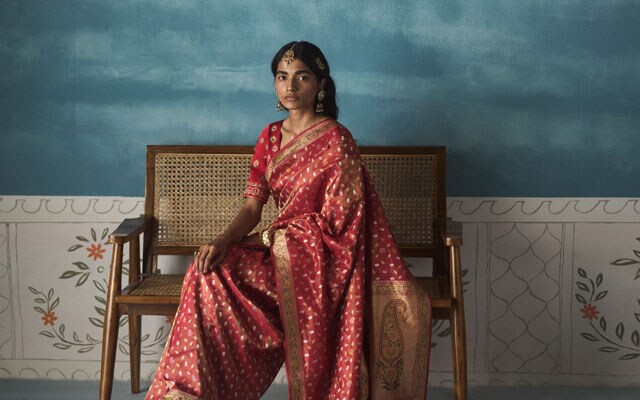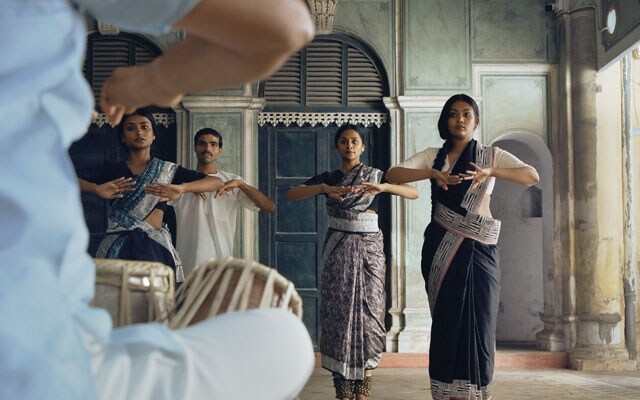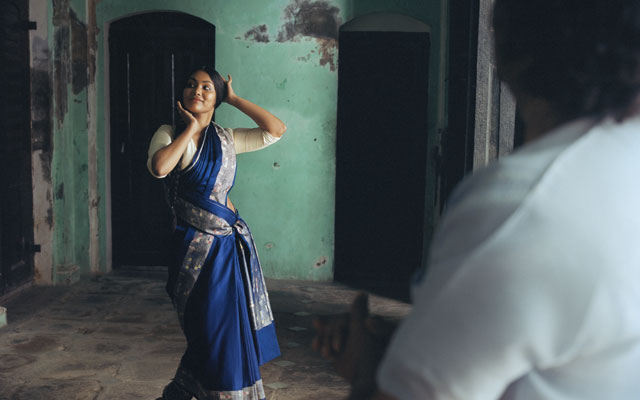Tilfi founders Udit Khanna, Ujjwal Khanna, and Aditi Chand: 'Vagaries of fashion don’t apply to us'
Tilfi founders Udit Khanna, Ujjwal Khanna, and Aditi Chand: 'Vagaries of fashion don’t apply to us'

A YOUNG and contemporary Benaresi label is slowly and steadily capturing the attention of connoisseurs. Tilfi, which opened as an ecommerce-only site in 2016, launched its first store in 2021. In less than two years of retail, the label has become one of the more trusted names in Benaresi handloom saris. So much so that its founders are confident enough to start a ready-to-wear line.
Tilfi is cofounded by Udit Khanna and Aditi Chand, and Udit’s brother Ujjwal Khanna. The Khannas have been in the Benaresi business for five generations: their family had several companies that manufactured for other labels. “I always wanted to have my own enterprise, as opposed to joining the family business. Aditi and I were college sweethearts, and met as undergrad students in the USA,” Udit, 38, says. “We often came to Benares for holidays and would poke our noses in the operations side of the family companies.” When the couple heard one of their master weavers complain that his son wanted a regular job, instead of taking up weaving, the duo told him to insist he stay in the craft. “He said to me: ‘Why should he want to? You both are not in your family business too’. That really hit home, and I knew I had to come back, leave all my international enterprises,” Udit says.
The Benaresi is India’s most glamorous textile. It refers to the opulent silk brocade – buttery and shimmering fabric woven with multiple threads of gold and silver – and made in Varanasi, Uttar Pradesh, one of the oldest cities in the world, and among the holiest for Hindus and Buddhists. It has multiple design patterns – the kinkhwab, the tanchoi, the shikargah, the rangkat, the chouka, the ashrafi, the jangla. It has a delicious vocabulary too, the silk is called ‘katan’, the organza is called ‘kora’, a embroidery-like raised weave is called ‘kadwa’, and an interlocked weave is called ‘kadiyal’. All of these aid in the sari’s snob value for the well-versed connoisseur.

“The Benaresi is the ultimate classic sari. The zari adds so much drama to the textile, which is why it’s one of the most popular sari for brides. Its visual impact is like none other,” says Ujjwal, 29.
“But there’s so much more,” reasons Aditi, 37. “No other handloom fabric has the depth and breadth of expertise that a Benaresi does. It isn’t just a silk brocade, the weavers have so many facets and skills, they are just the most brilliant people.” Aditi points to the play of fabric found in Benaresis – satin, cotton, organza, gyasar, georgettes and even Bengal’s beloved muslin, the jamdani.
The term ‘tilfi’ is symbolic of so many things. It refers to a weaving technique where three colours of mina (coloured silk thread) run parallel. It stands for its three founders too. But also the three core values of the brand. Tilfi insists that everything they make uses only pure fabrics, that it is one hundred percent handmade and hand crafted, and finally, that every product must pay homage to Benares. These have laid the foundation of the label.
But everything Benaresi isn’t all shiny and luxurious like its sari. Varanasi is still very very poor. Only 30 percent of the city is employed, and only 40 percent of it is in the silk business. The city is the constituency of Prime Minister Narendra Modi and the hotbed of its polarising politics: especially since his government’s building of the Kashi Vishwanath temple quasi-modern complex and corridor, and its exclusion of the adjoining Gyanvapi mosque.

The Benaresi’s popularity is also its curse. The very sophisticated but artisanal handloom industry is under threat of powerlooms (they take three hours to make a sari, whereas handlooms take between three weeks to a whole year), and industrialised looms from China.
“Tilfi only works with handlooms, nothing is made on a power loom, not even georgettes where the penetration is very high,” Aditi avers. “Power looms shouldn’t be called Benaresis, only handlooms should. Like champagne is called champagne only if it’s grown in that area of France.”
The speciality of Tilfi saris is that they are fully craft-led. “We are determined to let the artisans’ work shine through. We will choose a more complex style, even though it takes much longer and makes bad business sense,” Aditi smiles. “For example, we’re okay if a sari takes two months to make, and not have a simpler variation made in 10 days. We will not make a regular tissue sari, but make one with an ektaara thread. We believe in doing justice to the artisan’s skills.”

“Our approach is toward pushing the boundaries of the Benaresi. Our saris draw from classic and traditional patterns but we believe in innovation. For example, we have just created an artwork for an important public building which was incredibly challenging to produce. A loom with 5,000 punch cards on it is considered complex; this artwork has 45,000 cards,” Ujjwal says. Tilfi is especially popular for its design interventions, like a cityscape of the ghats on a border, or a contemporary patterned jamdani. Their Dam Pach saris, where the discontinuous weave on silk looks like a painting, are simply gorgeous.
They also famously never go on sale. “It is a mindful decision. The value of something handmade cannot go down, and these skills are only going to get rarer,” Aditi explains. “Vagaries of fashion don’t apply to us.”
Tilfi’s new collection is an ode to summertime or Chaitra, the first month of the Hindu calendar. Called ‘Gulab Bari’, it evokes a post-Holi festival played with petals of the Chaiti rose with players wearing pink and white clothes. “It plays with georgette, which is very popular in Benares as it is woven in white and then dyed in colour. You can have fun with georgettes, like even dye a sari ombre,” Aditi says.
The brand’s popularity is sought by NRIs everywhere in the world – USA of course but even Greece and Japan– but also several Middle-eastern royals, naturally attracted to its shimmer. “We are glad to find discerning clients from across the world,” Aditi says. “Tilfi was never born to shout, we like to whisper.”
Namrata Zakaria is a seasoned writer and editor, and a chronicler of social and cultural trends. Her first book, on late fashion designer Wendell Rodricks’ Moda Goa museum, is due to be published shortly. Zakaria is especially known for her insider’s take on fashion, luxury and social entrepreneurship in India. Her writing is appreciated for shaping opinions, busting myths, making reputations and sometimes breaking the odd career. Zakaria is also involved in putting together philanthropic efforts in the field of economic and environmental sustainability.
Read all the Latest News, Trending News, Cricket News, Bollywood News, India News and Entertainment News here. Follow us on Facebook, Twitter and Instagram.
What's Your Reaction?



























































